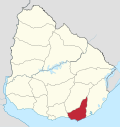|
Maldonado, Uruguay
Maldonado (Spanish pronunciation: [maldoˈnaðo]) is the capital city of Maldonado Department, in eastern Uruguay. According to the 2023 Census, it is the fourth most populated city in the country, with about 90 thousand inhabitants. However, together with the cities of Punta del Este and San Carlos it makes up a conurbation with a population of over 135 thousand inhabitants. HistoryThe origin of Maldonado's name dates back to January 1530, when Sebastian Cabot, an Italian explorer, departed for Castilla and left his Lieutenant, Francisco Maldonado, at what became the bay of Maldonado. After the Treaty of Madrid, when they started to divide Spanish and Portuguese properties in that region of America, the military governor of Montevideo, José Joaquín de Viana, suggested to the King that they should establish two populations, one in Maldonado and the other in Minas. In August 1755, still waiting for a response from the King, Viana decided to leave with some families and head towards Portezuelo. It was there that Maldonado was founded. Viana later left the settlement, leaving the inhabitants with animals and sufficient supplies to live. The population survived and grew due to the profits from growing crops and raising livestock.[1] When he returned 20 months later, he brought seven indigenous families and incorporated them into the small village to bolster the population. He also moved the settlement to its modern site.[2] The buildings that are built around the town square in Maldonado, including the cathedral, are reminiscent of traditional Spanish style, giving evidence that the Spanish royalty was involved in the growth and development of Maldonado.[3] In May 1783, the population had grown and the villagers gave Don Luis Estremera the power to oversee the creation of a city council, thus legally establishing the city 25 years after Viana had founded it. After years of attempts, on March 14, 1787, an election was held and approved 8 days later, and the City Council of Maldonado was elected and the Town of Maldonado became the City of San Fernando De Maldonado in honor of Ferdinand VI of Spain. With a City Council established, the people of Maldonado could defend their rights as citizens. GeographyIt is located on Route 39 and shares borders with Punta del Este to the south, Pinares – Las Delicias to the south and to the east, and suburb La Sonrisa to the north. Together they all form a unified metropolitan area. The next city to the north is San Carlos, only 13 kilometres (8.1 mi) away on Route 39. East of the city flows the stream Arroyo Maldonado. Climate Maldonado has an oceanic climate (Köppen: Cfb) with mild winters and without snow. The summers are warm (recently hot occasionally), similar to southeastern Australia. By being in the way of the Malvinas/Falkland current and in the bottleneck of the continent it generates a rare temperate climate typically of the ocean on the east coast. But the city is close to a humid subtropical climate (Cfa), consolidating in the coming decades.[4][5][6] PopulationIn 2011 the city of Maldonado had a population of 62,590.[7] According to the Intendencia Departamnetal de Maldonado, the municipality of Maldonado has a population of 105,000.[8] 
Source: Instituto Nacional de Estadística de Uruguay[9] Main sightsRemarkable sights in Maldonado include:
Places of worship
Notable residents
See alsoReferences
External linksWikimedia Commons has media related to Ciudad de Maldonado. Wikivoyage has a travel guide for Maldonado.
|
||||||||||||||||||||||||||||||||||||||||||||||||||||||||||








